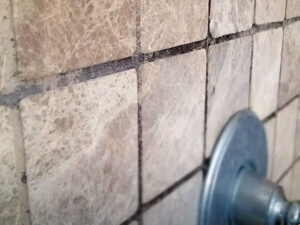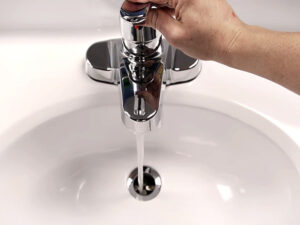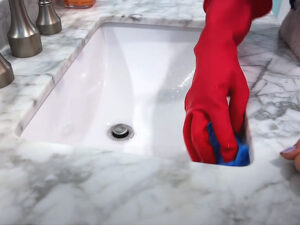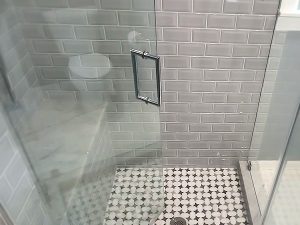A blocked bathroom sink drain is a common problem for homeowners, and it can disrupt daily life. Most of the time, the main cause of this problem is the harmless but widespread buildup of hair. In this helpful guide, we will provide you with a detailed and easy-to-follow process to clean your bathroom sink drain. We will explain different methods in depth, so you can effectively clean your drain without just using quick fixes. Additionally, we will discuss ways to protect your plumbing from future clogs caused by hair.
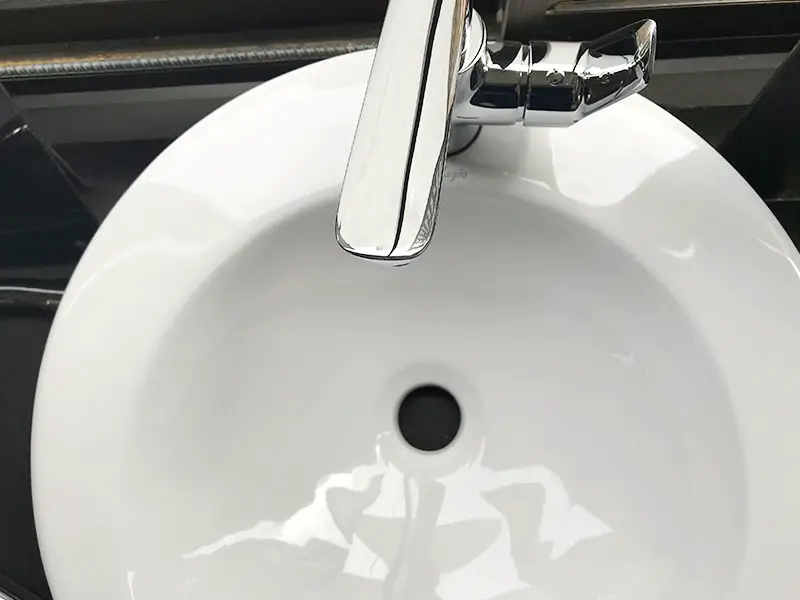
Understanding the Hair Clog Dilemma
Hair clogs are not just made up of one strand. They are a mixture of loose strands, soap residue, leftover shampoo, and other debris that sneakily make their way into your drain while you wash and groom.
Over time, this harmless combination turns into a dense and stubborn blockage, making it difficult for water to flow smoothly. This blockage not only causes problems but also leads to more plumbing issues.
To understand how serious the problem is, imagine your drain as an important artery in your home’s circulatory system. When hair and other things block this important pathway, it’s like a clot blocking the flow of blood. Your sink can block the water flow, causing slow drainage and possible overflow.
To understand this problem, it’s important to not only recognize the symptoms but also appreciate the underlying causes. If you don’t understand this, trying to solve the problem is like treating the symptoms instead of the actual problem.
To effectively prevent and deal with hair clogs in your plumbing system, it’s important to understand how they form and the problems they cause.
The Culprits: Strands, Soap, Shampoo, and Debris
- Loose Strands: The primary contributor to hair clogs is, unsurprisingly, the hair itself. Whether long or short, strands find their way into the drain during showers, handwashing, or general grooming activities. Over time, these individual strands interweave, creating a net-like structure that traps other particles.
- Soap Residues: The soap we use for cleansing often leaves behind residues that can cling to the walls of pipes. When combined with hair, these residues create a sticky matrix that becomes an ideal trap for more debris.
- Shampoo Remnants: Shampoos, conditioners, and other hair care products contribute to the concoction. Their chemical composition can enhance the stickiness of the clog, making it more challenging to dislodge.
- Other Debris: Beyond hair and grooming products, various other debris, such as dirt, skin cells, and lint, can find their way into the drain. When mixed with hair, these substances can form a dense obstruction that is tough to eliminate using conventional methods.
The Consequences: Beyond Slow Drains
The consequences of neglecting a hair-clogged sink drain extend beyond the annoyance of slow drainage. This seemingly minor issue can escalate into more severe plumbing problems, including:
- Unpleasant Odors: The combination of trapped hair, soap, and other debris creates an environment conducive to the growth of bacteria and fungi, leading to foul odors emanating from your drain.
- Water Damage: Slow drainage can result in water pooling around the sink, potentially causing damage to your countertop, cabinets, and even the structural integrity of your home.
- Pipe Damage: The pressure exerted on pipes due to persistent clogs can lead to damage, corrosion, and leaks. Over time, this can necessitate costly repairs or replacements.
- Bacterial Growth: Stagnant water in clogged drains becomes a breeding ground for bacteria. This not only contributes to unpleasant smells but can also pose health risks.
Understanding Why a Complete Approach is Important
To effectively solve the problem of a hair clog, it’s important to take a thorough and all-encompassing approach. This guide will help you solve current clogs and teach you how to avoid them in the future. We aim to provide you with the necessary tools, materials, and easy-to-follow instructions so that you can confidently take care of your plumbing system.
In the following sections, we will look at different methods for cleaning, including traditional plunging techniques and eco-friendly baking soda and vinegar mixtures. Furthermore, we will talk about ways to prevent future plumbing problems and develop good habits to strengthen your plumbing system.
This will not only help you solve the current issue but also protect your plumbing in the long run. Get ready as we explore how to take care of your bathroom sink drain. We’ll learn useful tips and solutions along the way.
Tools and Materials
Before you start cleaning, make sure you have all the necessary tools and materials ready. Having the right equipment will make the task easier and faster. Here is a comprehensive list:
Tools:
- Plunger: A basic but indispensable tool for dislodging clogs.
- Zip-It Tool: A flexible plastic device designed for pulling out hair and debris.
- Wire Hanger: Straightened to function as an improvised drain snake.
- Rubber Gloves: Essential for maintaining hygiene during the cleaning process.
Materials:
- Baking Soda: A versatile cleaning agent with mild abrasive properties.
- Vinegar: An acidic solution that aids in breaking down organic matter.
- Boiling Water: Effective for flushing out dissolved debris.
- Salt: Enhances the effectiveness of boiling water in dissolving clogs.
- Dish Soap: Lubricates and helps dislodge accumulated hair.
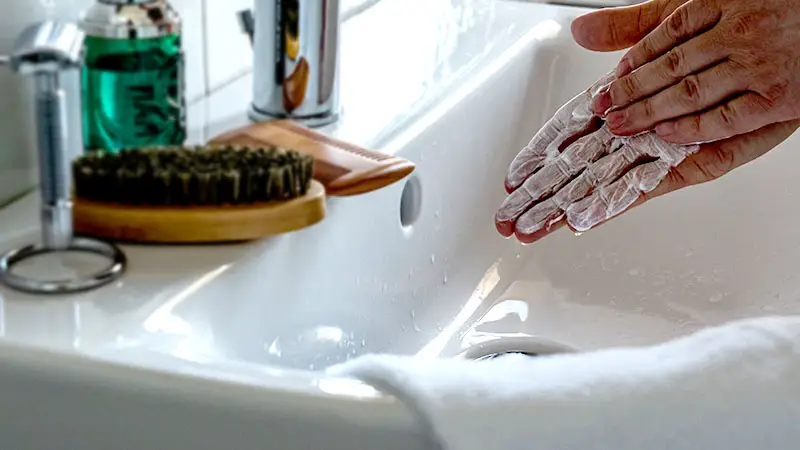
Method 1: The Plunger Technique
Step 1: Fill the Sink
Start by filling the sink with water until the rubber part of the plunger is completely covered. This water helps create a seal and makes plunging more effective.
Step 2: Position and Pump
Place the plunger directly on top of the drain, making sure it forms a secure seal. Hold the plunger tightly and move it up and down forcefully for about 20-30 seconds. When you compress and then release repeatedly, it creates pressure changes that can remove the hair blockage.
Step 3: Check and Repeat
After you push the plunger down, take it out and see if the water goes down easily. If the water is still draining slowly or staying still, try plunging again. Being persistent is important. Sometimes, it may take a few tries to completely clear the blockage.
Method 2: Using the Zip-It Tool
Step 1: Insert the Tool
The Zip-It tool is a thin and flexible plastic device made for removing hair and debris. Put it in the drain, pushing it as much as possible. The tool’s pointed tips help it move easily through the twists and turns of the drain.
Step 2: Pull and Extract
Gently remove the Zip-It tool from the drain. As you do this, it will grab onto and remove the gathered hair and dirt. Be careful not to apply too much force when using the tool to avoid causing any damage to your pipes.
Step 3: Dispose and Rinse
Put the extracted gunk in a trash bag. To make sure the drain is completely clean, pour hot water down it to wash away any leftover dirt. This step helps stop future clogs and makes sure the drainage system works well.
Method 3: Wire Hanger as a DIY Drain Snake
Step 1: Unwind and Hook
Take a wire hanger and unwind it, creating a straight piece of wire. Shape one end into a hook, forming a makeshift drain snake. This hook is essential for catching hair and debris within the drain.
Step 2: Insert and Fish Out
Gently insert the hooked end of the wire hanger into the drain, navigating it carefully to avoid any potential damage to the pipes. Once inserted, fish out the hair and debris, pulling them to the surface.
Step 3: Hot Water Flush
After successfully removing the clog, run hot water down the drain. The hot water helps flush out any remaining particles, providing a clean and unobstructed passage for water to flow.
Method 4: Baking Soda and Vinegar Magic
Step 1: Baking Soda Introduction
Start by pouring one cup of baking soda into the drain. Baking soda is a gentle scrubber. When mixed with vinegar, it creates a fizzy reaction that helps to dissolve the hair clog.
Step 2: Vinegar Infusion
Pour a cup of vinegar after the baking soda. Watch as the mixture bubbles and fizzes due to a chemical reaction. This fizziness helps remove and break down the hair and dirt that has built up in the drain.
Step 3: Patient Waiting and Flushing
Let the mixture of baking soda and vinegar sit for at least 30 minutes. This period enables the reaction to function efficiently. After the waiting period ends, use hot water to flush the drain and remove the broken down residue.
Method 5: Boiling Water and Salt Power Combo
Step 1: Boil the Water
Start by boiling a kettle of water. The boiling water serves as a potent tool for dissolving hair and other debris within the drain.
Step 2: Salt Introduction
Pour half a cup of salt down the drain. The abrasive nature of salt, combined with the heat from the boiling water, enhances the cleaning power.
Step 3: Boiling Water Flush
Follow the salt with the boiling water, ensuring it directly reaches the clogged area. The boiling water dissolves the clog, and the salt further aids in breaking down any residual matter.
Method 6: Dish Soap Lubrication for Easy Removal
Step 1: Dish Soap Squirt
Squirt a generous amount of dish soap down the drain. Dish soap acts as a lubricant, making it easier for hair and debris to slide through the pipes.
Step 2: Patient Waiting
Allow the dish soap to sit in the drain for 15-20 minutes. This waiting period allows the soap to penetrate and loosen the clog, facilitating its removal.
Step 3: Hot Water Flush
After the waiting period, run hot water down the drain. The combination of dish soap and hot water helps dislodge and flush out the soap, hair, and debris, leaving your drain clear and flowing smoothly.
By meticulously following these steps for each method, you can choose the approach that best suits your situation and the materials at hand. Remember, persistence and regular maintenance are key to keeping your bathroom sink drain free from hair clogs.
Prevention Tips: Maintaining a Clog-Free Drain
Having successfully tackled the hair clog in your bathroom sink drain, it’s crucial to adopt preventive measures to avoid future blockages. Here are some detailed tips:
1. Use a Hair Catcher
Install a hair catcher over the drain to trap loose hair before it enters the pipes. Clean the catcher regularly to maintain its effectiveness.
2. Regular Drain Maintenance
Perform drain-cleaning methods regularly, even when there isn’t a noticeable clog. This proactive approach prevents the accumulation of hair and other debris.
3. Weekly Hot Water Rinse
Once a week, pour a kettle of boiling water down the drain to dissolve any potential build-up. This routine maintenance helps keep your drain clear and flowing smoothly.
4. Avoid Chemical Drain Cleaners
Chemical drain cleaners can be harsh on your pipes and the environment. Opt for natural methods to prevent damage and promote eco-friendly practices.
Frequently Asked Questions (FAQs)
How often should I clean my bathroom sink drain to prevent clogs?
It’s advisable to clean your bathroom sink drain at least once a month to prevent the accumulation of hair and debris. Regular maintenance is key to a smoothly flowing drain.
Are chemical drain cleaners safe to use for clearing hair clogs?
Chemical drain cleaners can be harsh on pipes and the environment. It’s recommended to use natural methods like baking soda and vinegar to avoid potential damage to your plumbing.
Can I use the same methods for both metal and PVC pipes?
Yes, the mentioned methods are generally safe for both metal and PVC pipes. However, exercise caution when using tools like the wire hanger to avoid scratching or damaging the pipes.
What should I do if none of the DIY methods work?
If the DIY methods prove ineffective, it might be time to seek professional help. A plumber can use specialized tools to address more stubborn clogs and assess the overall health of your plumbing system.
Is it normal for my bathroom sink to have a lingering odor even after cleaning?
Lingering odors could indicate bacterial growth in the drain. Consider using a mixture of baking soda and vinegar periodically to keep the drain smelling fresh.
Can I use the same methods for a double sink?
Yes, the methods can be applied to both single and double sinks. Ensure to cover one drain while working on the other to create a seal and maximize the effectiveness of the cleaning method.
How can I prevent my hair from clogging the drain in the first place?
Invest in a hair catcher for your drain. These inexpensive devices are designed to trap hair before it enters the drain, significantly reducing the likelihood of clogs.
Can I use cold water instead of hot water to flush the drain?
Hot water is preferred as it helps dissolve substances more effectively. However, if you’re using a method that doesn’t involve heat, such as the Zip-It tool, cold water can still be used for flushing.
Are there any DIY drain cleaning methods that are eco-friendly?
Yes, methods like using baking soda, vinegar, and hot water are eco-friendly alternatives to chemical drain cleaners. They are safe for your pipes and the environment.
What should I do if I accidentally push the Zip-It tool too far into the drain?
If the Zip-It tool gets stuck or is pushed too far, carefully pull it back out. If you encounter resistance, do not force it, as this may cause damage. Seek professional assistance if needed.
Final Words
Keeping your bathroom sink drain clean and unclogged doesn’t have to be difficult. You can say goodbye to hair clogs and keep your plumbing in great shape by following the simple steps in this guide. To keep your bathroom sink drain working smoothly without any problems, it’s important to regularly maintain it and take preventive measures. Try using these methods to have a drain that flows smoothly and enjoy the satisfaction it brings. Have a great day!



